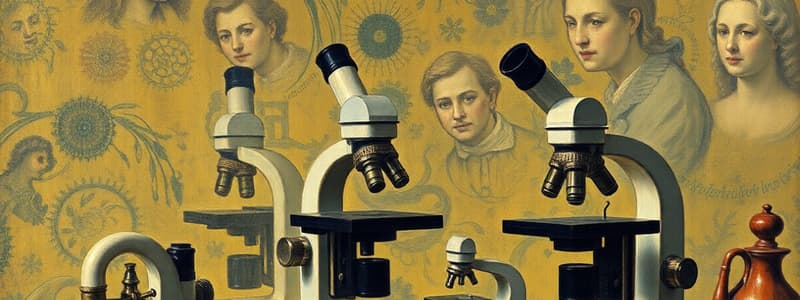Podcast
Questions and Answers
What is the primary purpose of microscopes in scientific studies?
What is the primary purpose of microscopes in scientific studies?
- To enhance the brightness of images
- To measure the size of cells
- To observe large living organisms
- To observe extremely small organisms (correct)
Who invented the first practical microscope, and in what time period?
Who invented the first practical microscope, and in what time period?
- Galileo Galilei in the early 1600s
- Robert Hooke in the late 1600s
- Louis Pasteur in the 1800s
- Antonie van Leeuwenhoek in the mid-1660s (correct)
What differentiates a monocular microscope from a binocular microscope?
What differentiates a monocular microscope from a binocular microscope?
- The size of the lenses used
- The number of ocular lenses (correct)
- The type of light source used
- The ability to measure magnification
What is the common type of microscope primarily used in science laboratories?
What is the common type of microscope primarily used in science laboratories?
What aspect of the compound microscope allows scientists to view specimens at different levels of detail?
What aspect of the compound microscope allows scientists to view specimens at different levels of detail?
Flashcards
Importance of microscopes
Importance of microscopes
Microscopes are tools used to observe living organisms too small to see with the naked eye.
Antonie van Leeuwenhoek
Antonie van Leeuwenhoek
Dutch scientist who invented a practical microscope in the mid-1600s.
Compound light microscope
Compound light microscope
Common microscope with two lenses (objective and ocular) used in labs to see tiny objects.
Objective lens
Objective lens
Signup and view all the flashcards
Microscopic Organisms
Microscopic Organisms
Signup and view all the flashcards
Study Notes
Microscopes and Microscopic Cells
- Microscopes are essential tools for studying small organisms, like cells.
- Microscopes enable observation of living organisms too small to see with the naked eye.
- Early microscopes were invented by Antonie van Leeuwenhoek in the mid-1660s. He used them to observe protozoa, bacteria, and other microscopic organisms.
- Technological advancements have led to more sophisticated microscope types designed to meet different needs.
Microscope Parts and Functions
- Compound light microscopes are common in labs.
- They have two main lenses: an objective lens and an ocular lens.
- A monocular microscope has one ocular lens.
- A binocular microscope has two ocular lenses.
- Objective lenses provide varying magnification power.
Studying That Suits You
Use AI to generate personalized quizzes and flashcards to suit your learning preferences.




